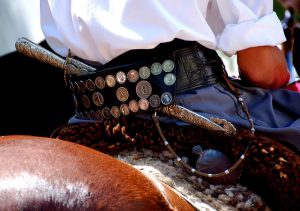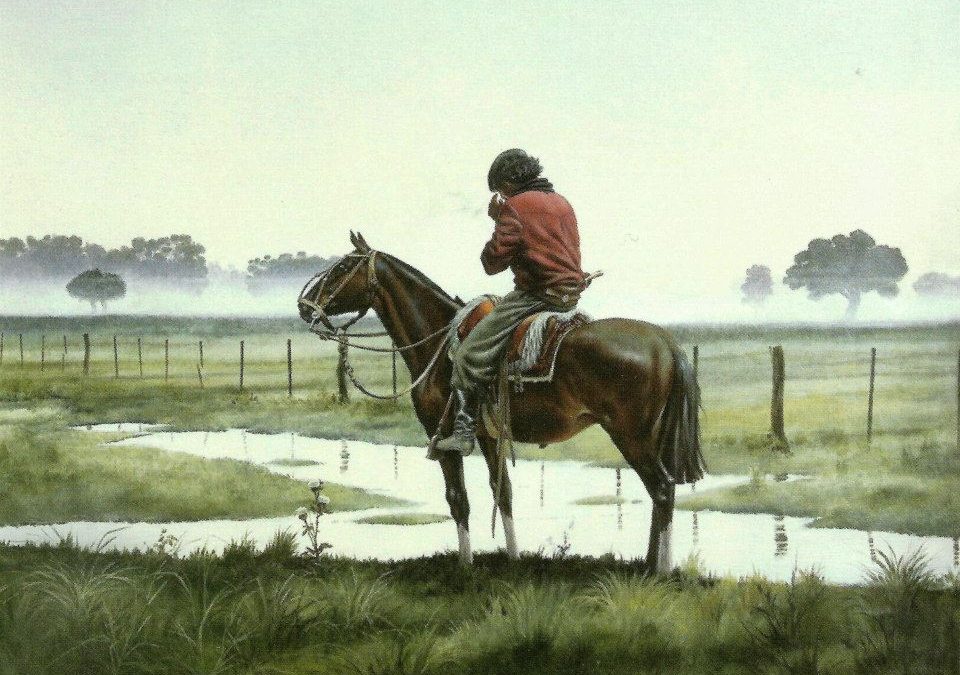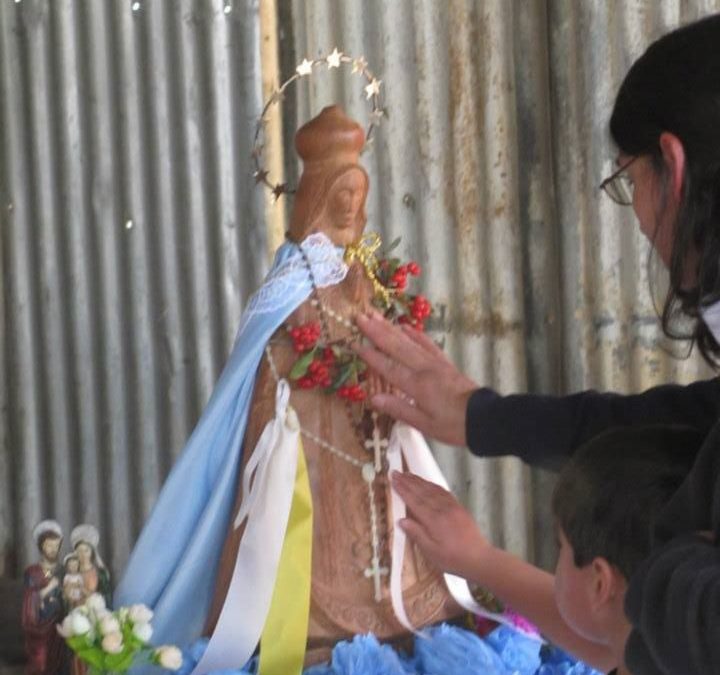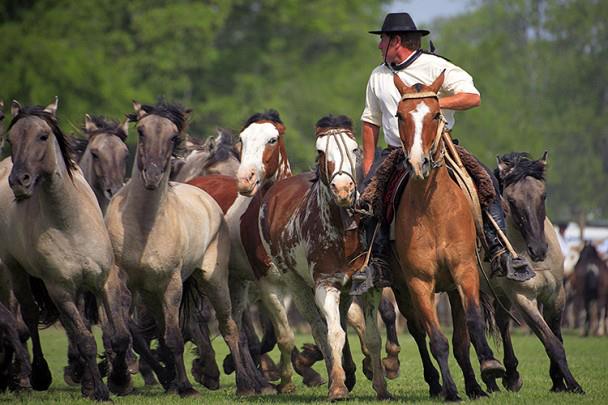
by Carolina González | Sep 11, 2016 | Horses, Traditions
Gaucho normally denotes the residents or inhabitants of the South American pampas or grasslands. They are almost like the North American “cowboy” who have the genuine profession of herding the cattle and practice hunting to meet their economic needs.
Gauchos are nowadays considered as the symbol of the national pride of Argentina. They are tremendous horse riders and famous for their distinctive and conventional costumes.The Gauchos of Argentina love to eat beef along with the herbal infusion prepared from Yerba and feel delighted to roam with their horses in the massive grasslands of the country. The fascinating features of the Gauchos of Argentina are their traditional clothing items that mainly include “espadrilles” originally made with black canvas but are now produced with a wide range of colours and patterns; some are made with a rubber sole.
The bombachas are actually trousers made with strong cotton fabric traditionally in beige, white and black colors. These trousers can be easily be identified because of the button they have at the ankle which is used to narrow them.
Without horse boots the traditional gaucho dress is never completed. Sometimes these traditional horse boots were having no heels and were open at the ends while some were made of leather with heels and they were known as “patriotic boots”. The northern Argentine gaucho boots often have folds that resemble bellows, i.e. leather legs “cordoned off” as a way of defending the forest and possible snake bites.
Gauchos of Argentina had the trend to wear their traditional pants particularly by women. These loose pants are like Capri pants and are normally knee lengths having a woven cuff with “guarda pampa” design, as well as a high and wide belted waist. The women of Argentina traditionally love to wear the costumes prepared with embellished patterns and in bright colors.
The warrior Gaucho costume is truly symbolic in Argentina as an emblem of prestige and the Argentine people feel proud on their traditional dress.

The Gaucho Clothing Store – Providers of authentic traditional gaucho clothing and gear

by Carolina González | Aug 29, 2016 | Estancias, Horses, Las Pampas, Traditions, Travel
Estancia relax in the Pampa Region
The Pampa is home to one of the most enduring images of Argentina: the gaucho on horseback, roaming the plains. All over the pampas there are quiet, unspoiled towns where gaucho culture is still very much alive. One of impeccably preserved gaucho towns very much worth visiting are San Antonio de Areco. The former is home to expert craftsmen, working silver and leather in the traditional gaucho way.
Many estancias are located in the Pampas region, the fertile South American lowlands covering more than 289,577 square miles. This region produces some of the best polo ponies in the world.
With a lack of beach destinations in Argentina, estancias also fulfil the role of being a place to come and relax. Beautifully trimmed gardens surrounding swimming pools and the ‘make yourself at home’ approach of many owners provides a lovely opportunity to take it easy during your Argentina trip.
The estancias offer many different activities. Some estancias, such as Estancia El Colibri and Estancia Villa Maria, El Ombu de Areco, Estancia Hotel Cecilia those allows guests to get involved with traditional activities with horses and the meals are based around the traditional Argentine ‘asados’ (barbecues) and ‘pucheros’ (stews).
You can check here about a complete Tour San Antonio de Areco with Estancia
Also if you prefer just to spend the day at an Estancia near Buenso Aires: Estancia el Ombú with transportation from Buenos Aires

by Carolina González | Aug 9, 2016 | Estancias, Las Pampas, Traditions
ARECO : CRADLE OF TRADITION.
In recent decades , San Antonio de Areco became the quintessential Creole enclave . With good hotels and restaurants, the experience in Areco is filled pure tradition. If the pampa treasures as its maximum cultural heritage everything related to the gaucho, then San Antonio de Areco is “the” symbol of this. Areco became known thanks to Ricardo Güiraldes , who set his novel ” Don Segundo Sombra ” in this town. It is no coincidence that the writer has been inspired by these vast fields of the plain, since the story of his character is related to the fact that the writer spent time in the Estancia La Porteña , owned by his father.
ARECO: BASTIÓN DE LA TRADICIÓN
En las últimas décadas, San Antonio de Areco se transformó en el enclave criollo por excelencia. Con buena hotelería y gastronomía, la experiencia es a pura tradición. – Si la pampa atesora como su máximo legado cultural lo relacionado con lo gauchesco, San Antonio de Areco es “el” símbolo de ello. Se hizo conocido por Ricardo Güiraldes, quien situó su novela “Don Segundo Sombra” en estos pagos. No es casualidad que el escritor se haya inspirado en estos vastos campos de la llanura, ya que la historia de su personaje está relacionada con las estadías que el escritor pasaba en la estancia La Porteña, propiedad de su padre.

by Carolina González | Aug 9, 2016 | Las Pampas, Traditions
A REAL TRADITIONAL PARTY. On Sunday July 28, while the people vibrated to the sound of the engines of the Federal Rally, a group of civilians passed at a slow pace, accompanied by the image of Our Lady of Itatí, they were going to the old post of traffic police at the RP41, where the mass and then the Creole party was going to take place.And we were dazzled. We found a gathering of “real” gauchos and countrywomen. No makeup, no commercial pollution, with the untidiness of a meeting made between friends; where the customs were crudely shown; without “banners”, powerful stereos or speakers with fake voices.An improvisation dominated the place: in the parking lot they were charging a token entry ($ 10.-) for the benefit of a rural school, and also the priest asked for a singer among the people and a guitar for the celebration.And then the riding skills came, also music and long conversations between peers. It is worth noticing that three-quarters of the attendees were fellow countrymen and countrywomen. Culturally speaking, a moving party.Finally, some thoughts: No need to be scared by great sceneries, famous artists, speakers and fireworks at subsidized festivals. While these countrymen make these meetings, the tradition is not at risk
UNA VERDADERA FIESTA PAISANA. El domingo 28 de julio, mientras el pueblo vibraba al son de los motores del Rally Federal, un grupo de paisanos a paso lento, acompañaba la imagen de Nuestra Señora de Itatí al viejo puesto de la policía caminera sobre la RP41, lugar de la celebración de la misa de campo y luego la fiesta criolla.
Y allí nos deslumbramos. Descubrimos una reunión de gauchos y paisanas “de verdad”. Sin maquillajes, sin contaminación comercial, con la desprolijidad de una reunión hecha entre amigos; en donde los usos y costumbres se mostraron crudamente; sin “banners” de organismos, ni poderosos equipos de sonido, ni locutores con voz impostada.
Una simpática improvisación dominaba el espectro: desde el estacionamiento, al cobro de una entrada simbólica ( $ 10.-) a beneficio de una escuela rural, a la misa de campo en donde el sacerdote tuvo que pedir por una cantante entre los fieles y una guitarra para la celebración.
Y luego llegaron las destrezas a caballo, la música y las largas charlas entre pares. Por tratarse de la Virgen de Itatí, la fiesta tuvo un fuerte acento litoraleño ya sea por la música de fondo, como el conjunto de chamamé que se presentó “delante” de un desvencijado escenario armado con palos y chapas viejas pero que en su conjunto nos hacía volar a las temperas de Florencio Molina Campos.
Cabe destacar que las tres cuartas partes de los asistentes eran paisanos y paisanas. Culturalmente hablando, una fiesta conmovedora.
Finalmente, una reflexión: No nos tenemos que asustar por grandes escenarios, artistas famosos, altoparlantes y los fuegos artificiales en las fiestas subsidiadas. En tanto existan y se realicen estas reuniones de paisanos, la tradición no corre riesgos.
sanantoniodeareco.travel

by Carolina González | Aug 9, 2016 | Events, Horses, Las Pampas, Traditions
The town besides being a cultural landmark of tradition, it is home since 1939 of the Tradition Festival , the oldest gaucho celebration of Argentina . This is a national event which starts eight days before the Week of Tradition and closes with an impressive parade of civilians and gaucho skills in the Ricardo Güiraldes Criollo Park.It is a festival in which Areco is shown with its own identity and where the only protagonists are the peasants , artisans , musicians , dancers and artists: pure and genuine folklore , which has allowed the arequeros to be custodians of the noble traditions that make the Argentinian identity . The gaucho , proud of the past, renovates in the Tradition Festival its commitment to a certain lifestyle .
SPANISH:
El Pueblo además de ser un mojón cultural de la tradición, es sede desde 1939 de la Fiesta de la Tradición, la celebración gaucha más antigua de Argentina. Se trata de un acontecimiento nacional que se inicia ochos días antes con la Semana de la Tradición y cierra a lo grande con el impresionante desfile de paisanos y las destrezas gauchas en el Parque Criollo Ricardo Güiraldes.
Es una festividad en la que Areco se muestra con su propia identidad y donde los únicos protagonistas son los paisanos, artesanos, músicos, bailarines y artistas: folclore puro y genuino, que le ha permitido a los arequeros ser custodios de las nobles tradiciones que componen el ser argentino. El gaucho, orgulloso del pasado, renueva en la Fiesta de la Tradición su compromiso por un estilo de vida.

by Carolina González | Aug 9, 2016 | Las Pampas, Traditions
Areco’s charms: Rainy day, a chilly wind starts blowing provides a welcome relief after a grueling week. Dark clouds cover sky, the day almost becomes night; then some timid drops begin to drop. The temperature continues to fall, and it is a pleasure to open windows wide for that refreshing breeze to flood the warm environments. … The sound of rain drops hitting a million ceilings is an incomparable orchestra. Plants and flowers breathe relieved and drink tasty water provided by the sky. After a while, the rain stops, the feeling of freshness and the smell of damp earth and wet grass invades every corner. In the yard the green grass looks alive, punctuated by drops that reflect the light of a gray day.The rain in San Antonio de Areco has a special meaning. Several of the neighbors seem to wait for the rain to go knock on a door. The phone also sounds. The order is the same, everyone knows that a rainy day is synonymous of fried cakes or “tortas fritas”. It’s a habit, it is impossible to deter them. The options are many, cookies, invoices, cakes, but the first thing everyone asks are fried cakes.
UN DIA GRIS EN ARECO: TORTAS FRITAS Y SUS SECRETOS
Día lluvioso, comienza soplando un viento fresquito que brinda un muy esperado alivio después de una semana agotadora. Las nubes oscuras cubren el cielo, el día se apaga y casi que se hace noche; luego comienzan a caer algunas tímidas gotas. La temperatura sigue descendiendo, y es un placer abrir ventanas de par en par para que esa brisa renovadora inunde los cálidos ambientes. Llueve…El sonido de millones de gotas golpeando los techos es una orquesta incomparable. Las plantas y flores respiran aliviadas y beben gustosas las aguas que brinda el cielo. Luego de un tiempo, lentamente se detiene el golpeteo, la sensación de frescura y el olor a la tierra húmeda y la hierba mojada invade cada rincón. En el patio todo el verde se ve más vivo, salpicado por gotas que reflejan la luz de un día gris.
La lluvia por estos lados tiene un significado especial. Varios de los vecinos parece que esperaran la lluvia para ir a golpear una puerta. El teléfono también suena. El pedido es el mismo, todos saben que un día de lluvia es sinónimo de tortas fritas. Ya es una costumbre, es imposible disuadirlos. Las opciones son muchas, masitas, facturas, tortas, pero lo primero que todos piden son tortas fritas.







